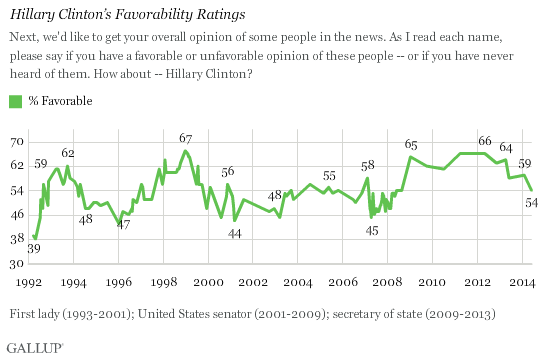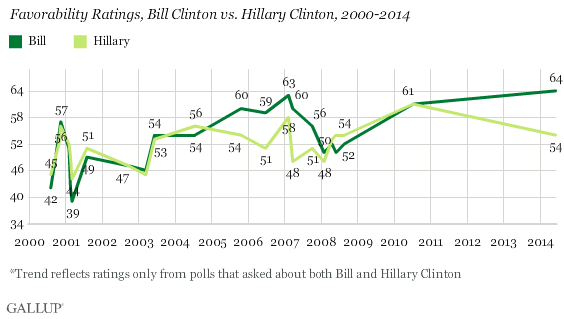WASHINGTON, D.C. -- Hillary Clinton's favorability rating has dropped slightly, although a majority of Americans continue to view her in a positive light. As Clinton publicizes her new memoir, "Hard Choices," 54% of Americans view her favorably. This is down from 59% in February, and significantly less than the ratings she received as secretary of state, which were consistently above 60%.

The latest findings come from a Gallup poll conducted June 5-8. Though Clinton has said she will not announce whether she'll run for president until at least later this year, her latest book has been widely framed as a preamble to another presidential bid and a move typical of White House hopefuls. Clinton already has the support of many elected officials and Democratic Party representatives if she chooses to run. Americans have named her their Most Admired Woman 18 times.
Clinton's current favorability rating is the lowest it has been since August 2008 (54%), when she was preparing to deliver a speech at the Democratic National Convention endorsing then-Sen. Barack Obama, who defeated her in a hard-fought primary battle for the party's 2008 presidential nomination.
After recovering from a contentious Democratic primary race that strapped her with campaign debt, Clinton's favorability soared while she served as secretary of state during Obama's first term. As she continued in her role, as many as two-thirds of Americans (66%) viewed her favorably, in consecutive polls in 2011 and 2012 -- a rating she surpassed only once before, at 67% in December 1998, shortly after her husband, President Bill Clinton, was impeached.
In her nonpolitical role as secretary of state, Clinton enjoyed extremely high ratings from her fellow Democrats, but saw her ratings increase among Republicans as well. She peaked with Republicans during this period in mid-2012, when 41% viewed her favorably. Her favorability fell with the GOP, as it did with independents, after the September 2012 attacks on the U.S. compound in Benghazi, Libya. As Democratic elected officials continue to encourage her to run for president, her name has become further politicized, thus making her less favorable to non-Democrats.

GOP operatives and media pundits have publicly questioned whether her health and age (Clinton is now 66) could hinder her ability to serve as president. Additionally, the House of Representatives has formed a select committee to investigate the attack in Benghazi. And as she wades into Obama's controversial decision to trade five Taliban prisoners held at Guantanamo Bay for U.S. soldier Bowe Bergdahl, Clinton's performance as one of Obama's top cabinet members will likely undergo greater scrutiny.
Bill Clinton's Effect on Hillary's Image
Bill Clinton, who in the same poll receives a 64% favorable rating, has commanded majority favorability from Americans during most of his time as president and in post-presidential life.
While some may view his high favorability ratings as an advantage for Hillary if she decides on another presidential run, Bill's favorability did take a hit when he joined her on the 2008 campaign trail. By January 2008 -- a year after Hillary announced her candidacy -- his favorability hit a five-year low of 50%, barely ahead of Hillary's 48%.
In fact, for much of Hillary's career since Bill's presidency, their favorability ratings have been closely related.

Their latest favorability ratings are separated by 10 percentage points and, with the exception of a 12-point difference in March 2007, are as far apart as they've been since Hillary independently entered the political fray as a candidate for the U.S. Senate from New York.
During Hillary's first term as New York's junior senator, her favorability was closely linked to that of her husband. But for the first three years of her second term, from 2005-2007, their ratings differed by five to 12 percentage points. Then, in early 2008, when Bill became a proxy campaigner for Hillary in her bid for the presidency, his favorability fell and their ratings converged.
Bottom Line
Hillary Clinton's era of higher favorability appears to be ending even before she announces whether she will run for president. Americans typically rate non-political figures higher than political ones on this measure, and her favorable ratings before, during, and after being secretary of state are consistent with that phenomenon.
Though her husband's influence is far from Hillary's greatest selling point, he may be better positioned to help her on the campaign trail than he was last time, with his favorability up five points from what it was in mid-2006. But if Hillary does run, the boost she receives from him may be limited if it is similar to 2008, with his past favorability so closely married to her own in the backdrop of a presidential campaign.
Survey Methods
Results for this Gallup poll are based on telephone interviews conducted June 5-8, 2014, with a random sample of 1,027 adults, aged 18 and older, living in all 50 U.S. states and the District of Columbia.
For results based on the total sample of national adults, the margin of sampling error is ±4 percentage points at the 95% confidence level.
Interviews are conducted with respondents on landline telephones and cellular phones, with interviews conducted in Spanish for respondents who are primarily Spanish-speaking. Each sample of national adults includes a minimum quota of 50% cellphone respondents and 50% landline respondents, with additional minimum quotas by time zone within region. Landline and cellular telephone numbers are selected using random-digit-dial methods. Landline respondents are chosen at random within each household on the basis of which member had the most recent birthday.
Samples are weighted to correct for unequal selection probability, nonresponse, and double coverage of landline and cell users in the two sampling frames. They are also weighted to match the national demographics of gender, age, race, Hispanic ethnicity, education, region, population density, and phone status (cellphone only/landline only/both, and cellphone mostly). Demographic weighting targets are based on the most recent Current Population Survey figures for the aged 18 and older U.S. population. Phone status targets are based on the most recent National Health Interview Survey. Population density targets are based on the most recent U.S. census. All reported margins of sampling error include the computed design effects for weighting.
In addition to sampling error, question wording and practical difficulties in conducting surveys can introduce error or bias into the findings of public opinion polls.
View survey methodology, complete question responses, and trends.
For more details on Gallup's polling methodology, visit www.gallup.com.
